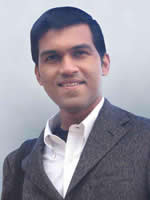Programme
Networking Important Dates
- Abstract submission
November 26, 2010 - Paper submission
December 10, 2010 - Acceptance Notification
January 31, 2011 - Camera Ready Due
February 15, 2011 - Networking Conference
9-13 May 2011
IFIP Networking 2010
CANDIDATE TUTORIALS
Tutorials Co-Chairs:
- Juan Carlos Cano Escribá Universidad Politecnica de Valencia, Spain (jucano@disca.upv.es)
- Dongkyun Kim Kyungpook National University, South Korea (dongkyun@mail.knu.ac.kr)
The 10th IFIP Networking 2011 Conference is pleased to offer the following half day tutorials:
Date: Monday, May 9th, 2011, 9.30am-13.30pm
Tutorial 1: "Biologically-inspired and Nano-scale Communication and Networking"
Prof. Ozgur B. Akan, Department of Electrical & Electronics Engineering, Koc University. Sariyer, Istanbul, Turkey akan@ku.edu.tr
Date: Monday, May 9th, 2011, 9.30am-13.30pm
Tutorial 2: "A Step-wise Roadmap for Future Converged, Packet-based Multilayer Architecture"
Dr. Juan-Pedro Fernández-Palacios Head of the Unit on “Metro and Core Transport Networks” Telefonica I+D jpfpg@tid.es
Date: Monday, May 9th, 2011, 14.30pm-18.30pm
Tutorial 3: "Cognitive Radio Networks: Fundamentals and Applications"
Prof. Tommaso Melodia, State University of New York at Buffalo, USA tmelodia@buffalo.edu
Prof. Kaushik R. Chowdhury, Northeastern University, Boston, MA krc@ece.neu.edu
Date: Monday, May 9th, 2011, 14.30pm-18.30pm
Tutorial 4: "Towards Holistic Green Communications and Networking"
Dr. Konstantinos Samdanis NEC Europe Ltd Konstantinos.Samdanis@neclab.eu
Dr. Dominique Dudkowski NEC Europe Ltd Dominique.Dudkowski@neclab.eu
Tutorials Information
Tutorial 1: "Biologically-inspired and Nano-scale Communication and Networking"

Prof. Ozgur B. Akan:
Prof. Ozgur B. Akan received the BS and MS degrees in electrical and electronics engineering from Bilkent University and Middle East Technical University, Ankara, Turkey, in June 1999 and January 2002, respectively. He received the PhD degree in electrical and computer engineering from the Broadband and Wireless Networking Laboratory, School of Electrical and Computer Engineering, Georgia Institute of Technology, Atlanta, in May 2004. He is currently Associate Professor with the Department of Electrical and Electronics Engineering, Koc University, Istanbul, Turkey and the Director of Next generation Wireless Communications Laboratory (NWCL). His current research interests are in next-generation wireless communications, biologically-inspired communications, nano-scale and molecular communications, network information theory.
Dr. Akan is an Associate Editor for IEEE Transactions on Vehicular Technology, International Journal of Communication Systems (Wiley), Nano Communication Networks Journal (Elsevier). He served as an Editor for ACM/Springer Wireless Networks (WINET) Journal (2004-2010), an Area Editor for AD HOC Networks Journal (Elsevier) (2004-2008), as a Guest Editor for several special issues. He is a TPC Co-Chair of ICST 5th International Conference on Nano-Networks (ICST Nano-Net 2011) and a TPC Co-Chair of ACM MSWIM 2010, served as the General Co-Chair for The Third International Conference on Bio-Inspired Models of Network, Information, and Computing Systems (ICST/IEEE BIONETICS 2008), the European Vice Chair for The Second International Conference on Nano-Networks (ICST/ACM Nano-Net 2007), an International Vice Chair for IEEE INFOCOM 2006, and in organizing committees and technical program committees of many other international conferences. He is an IEEE Senior Member (Communications Society). Dr. Akan received the IBM Faculty Award twice in 2010 and 2008, Turkish Academy of Sciences Distinguished Young Scientist Award 2008 (TUBA-GEBIP).
Summary:
The developments in communication technologies have yielded many existing and envisioned information network architectures such as cognitive radio networks, sensor and actor networks, quantum communication networks, terrestrial next generation Internet, and InterPlaNetary Internet. However, there exist many common significant challenges to be addressed for the practical realization of these current and envisioned networking paradigms such as the increased complexity with large scale networks, their dynamic nature, resource constraints, heterogeneous architectures, absence or impracticality of centralized control and infrastructure, need for survivability, and unattended resolution of potential failures. These challenges have been successfully dealt with by Nature, which, as a result of millions of years of evolution, have yielded many biological systems and processes with intrinsic appealing characteristics such as adaptivity to varying environmental conditions, inherent resiliency to failures and damages, successful and collaborative operation on the basis of a limited set of rules and with global intelligence which is larger than superposition of individuals, self-organization, survivability, and evolvability.
Inspired by these characteristics, many researchers are currently engaged in developing innovative design paradigms to address the networking challenges of existing and envisioned information systems. In this tutorial, the current state-of-the-art in bio-inspired networking is captured. The existing bio-inspired networking and communication protocols and algorithms devised by looking at biology as a source of inspiration, and by mimicking the laws and dynamics governing these systems is presented along with open research issues for the bio-inspired networking. Furthermore, the domain of bio-inspired networking is linked to the forthcoming research domain of nanonetworks, which bring a set of unique challenges. The objective of this tutorial is to provide better understanding of the potentials for bio-inspired and nano-scale networking, and to motivate research community to further explore this timely and exciting field
Tutorial 2. "A Step-wise Roadmap for Future Converged, Packet-based Multilayer Architecture"

Dr. Juan-Pedro Fernández-Palacios:
Dr. .Juan Pedro Fernández-Palacios Giménez graduated with a degree of Telecommunications Engineering from Polytechnic University of Valencia. In September of 2000 he joined Telefónica I+D where he has been working on the design and planning of optical networks within Telefónica Group. Currently he is leading the Metro and Core Transport Networks Unit in Telefónica I+D.
Summary:
Internet traffic growth is strongly impacting on metro and core network costs. Therefore, new architectural solutions able to face up with the huge expected traffic increase in a more cost-effective way will be needed in order to assure a low cost broadband Internet access. This tutorial synthesizes the STRONGEST project’s view by presenting the migration steps to be taken towards an end-to-end transport network architecture able to absorb the expected traffic increase while minimizing transport costs.
Tutorial 3. "Cognitive Radio Networks: Fundamentals and Applications"

Prof. Tommaso Melodia:
Prof. Tommaso Melodia is an Assistant Professor with the Department of Electrical Engineering at the University at Buffalo, The State University of New York (SUNY), where he directs the Wireless Networks and Embedded Systems Laboratory. He received his Ph.D. in Electrical and Computer Engineering from the Georgia Institute of Technology in June 2007. He had previously received his ``Laurea'' (integrated B.S. and M.S.) and Doctorate degrees in Telecommunications Engineering from the University of Rome ``La Sapienza,'' Rome, Italy, in 2001 and 2005, respectively. He is the recipient of the BWN‐Lab Researcher of the Year award for 2004. He coauthored a paper that was was recognized as the Fast Breaking Paper in the field of Computer Science for February 2009 by Thomson ISI Essential Science Indicators. He is an Associate Editor for the Computer Networks (Elsevier) Journal, IEEE Communications Surveys and Tutorials, and for the Journal of Sensors (Hindawi). He has served in the technical program committees of several leading conferences in wireless communications and networking, including IEEE Infocom, ACM Mobicom, and ACM Mobihoc. He was the technical co‐chair of the Ad Hoc and Sensor Networks Symposium for IEEE ICC 2009. His current research interests are in modeling and optimization of multi‐hop wireless networks, cross‐layer design and optimization, cognitive radio networks, wireless multimedia sensor and actor networks, underwater acoustic networks.

Prof. Kaushik R. Chowdhurya:
Prof. Kaushik R. Chowdhurya is Assistant Professor in the Electrical and Computer Engineering Department at Northeastern University, Boston, MA. He graduated with B.E. in Electronics Engineering with distinction from VJTI, Mumbai University, India, in 2003. He received his M.S. in Computer Science from the University of Cincinnati, OH, in 2006, and Ph.D. from the Georgia Institute of Technology, Atlanta, GA in 2009. His M.S. thesis was given the outstanding thesis award jointly by the ECE and CS departments at the University of Cincinnati. His Ph.D. thesis was titled "Communication Protocols for Cognitive Radio Ad Hoc Networks", the subject of this proposal. Kaushik's work on TCP, routing protocols, and link layer coordination schemes for cognitive radio networks have appeared in leading IEEE journals and conferences. He is currently serving as the guest editor of the Elsevier Ad Hoc Networks journal, special issue on Cognitive Radio Ad Hoc Networks. He is also teaching a graduate course in Cognitive Radio Networks at the Northeastern University in Fall'2010. He has served as the technical chair/co‐chair in several workshops on the topic of Cognitive Radio over the past several years.
Summary:
Existing wireless networks are characterized by a fixed spectrum assignment policy. However, it is well known that a consistent portion of the assigned spectrum is used sporadically and geographical variations in the utilization of the assigned spectrum range from 15% to 85% with a high variance in time. The limited available spectrum and the inefficiency in spectrum usage call for a new networking paradigm based on more flexible opportunistic utilization of the existing wireless spectrum. This new networking paradigm is referred to as cognitive radio network. In this tutorial, the new functionalities and current research challenges of cognitive radio networks are outlined and discussed in detail. More specifically, an overview of the cognitive radio technology is provided and key network architectures are introduced. Moreover, the main cognitive network functionalities such as spectrum sensing and decision, spectrum mobility and spectrum sharing are analyzed in detail. The influence of these functionalities on the design and performance of medium access control and upper layer protocols such as routing and transport are discussed. Furthermore, cross-layer design and other open research issues are covered in detail. Finally, current standardization and experimental activities are outlined.
Tutorial 4. "Towards Holistic Green Communications and Networking"

Dr. Konstantinos Samdanis:
Konstantinos Samdanis graduated from Brunel University in 2000 with a degree in electrical and electronic engineering (telecommunication systems). In 2003 he received his M.Sc. in telecommunications research and in 2009 his Ph.D. in mobile communications from King's College London. Konstantinos worked in the EVEREST IST project and as a teaching assistant in King’s College London as well as a research analyst at eGov Monitor before joining the NEC Laboratories Europe. Currently member of the network management group, he conducts research on 3GPP LTE self-organized net-works and energy saving in RANs, while he is also involved in the 3GPP SA5 group with numerous contributions in the field of energy management.

Dr. Dominique Dudkowski:
Dominique Dudkowski received his diploma in computer science in 2002 and his doctoral degree in mobile communications in 2009 from Stuttgart University, Germany. He worked as a research as-sistant in the Distributed Systems Group at University Stuttgart until he joined the Network Manage-ment Group of NEC Laboratories Europe in Heidelberg, Germany, in 2008. At the labs, he has been working on management principles and architectures for the future Internet and cloud networks within the large-scale EU projects 4WARD and SAIL. He is also developing energy-efficient solutions for large fixed networks, focusing on innovative data center energy management approaches based on OpenFlow technology. Dominique is a member of several technical program committees of key conferences and workshops that have emerged in green communications and networking in the past few years. He has also been a panelist on energy measurement in communication networks and involved in standardization of Internet-related energy consumption monitoring.
Summary:
The steadily rising energy cost and the need to reduce global CO2 emission to protect our environment are today’s economical and ecological drivers for the emerging consideration of energy consumption in all fields of communications and networking. After a steep increase of contributions, the energy-related research is currently entering a mature phase, in which specific solutions address energy conservation in particular parts of the network based on a specific set of constraints. Our tutorial presents and analyzes the most significant technical proposals considering radio access networks, heterogeneous access, core optical networks and the Internet, database systems as well as the device perspective in an effort to identify and summarize the main energy saving principles. A key objective of our tutorial is to go beyond the current state of the art and provide a view into a potential holistic end-to-end energy analysis that combines and extends the current set of energy saving techniques. Such a holistic approach aims to combine wireless and wired research joining our experience from both fields.






